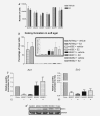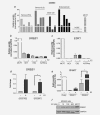17β-estradiol upregulates GREB1 and accelerates ovarian tumor progression in vivo
- PMID: 24469735
- PMCID: PMC4235304
- DOI: 10.1002/ijc.28741
17β-estradiol upregulates GREB1 and accelerates ovarian tumor progression in vivo
Abstract
Exogenous 17β-estradiol (E2) accelerates the progression of ovarian cancer in the transgenic tgCAG-LS-TAg mouse model of the disease. We hypothesized that E2 has direct effects on ovarian cancer cells and this study was designed to determine the molecular mechanisms by which E2 accelerates ovarian tumor progression. Mouse ovarian cancer ascites (MAS) cell lines were derived from tgCAG-LS-TAg mice. Following intraperitoneal engraftment of two MAS cell lines, MASC1 and MASE2, into SCID mice, exogenous E2 significantly decreased the survival time and increased the tumor burden. Microarray analysis performed on MASE2-derived tumors treated with E2 or placebo showed that E2 treatment caused the upregulation of 197 genes and the downregulation of 55 genes. The expression of gene regulated by estrogen in breast cancer 1 (Greb1) was upregulated in mouse tumors treated with E2 and was overexpressed in human ovarian cancers relative to human ovarian surface epithelium, suggesting a role for GREB1 in human ovarian tumor progression. RNA interference-mediated knockdown of GREB1 in MASE2 cells decreased their proliferation rate in vitro and increased survival time in mice engrafted with the cells. These results emphasize the importance of E2 in ovarian tumor progression and identify Greb1 as a novel gene target for therapeutic intervention.
Keywords: GREB1; estrogen; microarray; mouse model; ovarian cancer.
© 2014 The Authors. Published by Wiley Periodicals, Inc. on behalf of UICC.
Figures





Similar articles
-
Estradiol promotes cell survival and induces Greb1 expression in granulosa cell tumors of the ovary through an ERα-dependent mechanism.J Pathol. 2022 Mar;256(3):335-348. doi: 10.1002/path.5843. Epub 2022 Jan 4. J Pathol. 2022. PMID: 34860414
-
GREB1 is an estrogen receptor-regulated tumour promoter that is frequently expressed in ovarian cancer.Oncogene. 2018 Nov;37(44):5873-5886. doi: 10.1038/s41388-018-0377-y. Epub 2018 Jul 4. Oncogene. 2018. PMID: 29973689 Free PMC article.
-
ElncRNA1, a long non-coding RNA that is transcriptionally induced by oestrogen, promotes epithelial ovarian cancer cell proliferation.Int J Oncol. 2017 Aug;51(2):507-514. doi: 10.3892/ijo.2017.4030. Epub 2017 Jun 7. Int J Oncol. 2017. PMID: 28714515
-
Identification of miR-26 as a key mediator of estrogen stimulated cell proliferation by targeting CHD1, GREB1 and KPNA2.Breast Cancer Res. 2014 Apr 15;16(2):R40. doi: 10.1186/bcr3644. Breast Cancer Res. 2014. PMID: 24735615 Free PMC article.
-
Consideration of GREB1 as a potential therapeutic target for hormone-responsive or endocrine-resistant cancers.Expert Opin Ther Targets. 2014 Sep;18(9):1065-76. doi: 10.1517/14728222.2014.936382. Epub 2014 Jul 5. Expert Opin Ther Targets. 2014. PMID: 24998469 Review.
Cited by
-
Nursing Genetic Research: New Insights Linking Breast Cancer Genetics and Bone Density.Healthcare (Basel). 2020 Jun 15;8(2):172. doi: 10.3390/healthcare8020172. Healthcare (Basel). 2020. PMID: 32549322 Free PMC article.
-
Development of a multi-marker model combining HE4, CA125, progesterone, and estradiol for distinguishing benign from malignant pelvic masses in postmenopausal women.Tumour Biol. 2016 Feb;37(2):2183-91. doi: 10.1007/s13277-015-4037-3. Epub 2015 Sep 9. Tumour Biol. 2016. PMID: 26349751
-
Oncogenic mutation in RAS-RAF axis leads to increased expression of GREB1, resulting in tumor proliferation in colorectal cancer.Cancer Sci. 2020 Oct;111(10):3540-3549. doi: 10.1111/cas.14558. Epub 2020 Aug 31. Cancer Sci. 2020. PMID: 32629543 Free PMC article.
-
Active Estrogen Receptor-alpha Signaling in Ovarian Cancer Models and Clinical Specimens.Clin Cancer Res. 2017 Jul 15;23(14):3802-3812. doi: 10.1158/1078-0432.CCR-16-1501. Epub 2017 Jan 10. Clin Cancer Res. 2017. PMID: 28073843 Free PMC article.
-
Single-cell sequencing reveals transcriptional dynamics regulated by ERα in mouse ovaries.PLoS One. 2024 Nov 21;19(11):e0313867. doi: 10.1371/journal.pone.0313867. eCollection 2024. PLoS One. 2024. PMID: 39570927 Free PMC article.
References
-
- Siegel R, Ma J, Zou Z, Jemal A. Cancer statistics, 2014. CA Cancer J Clin. 2014;64:9–29. - PubMed
-
- Naora H, Montell DJ. Ovarian cancer metastasis: integrating insights from disparate model organisms. Nat Rev Cancer. 2005;5:355–66. - PubMed
-
- Lacey JV, Jr, Mink PJ, Lubin JH, et al. Menopausal hormone replacement therapy and risk of ovarian cancer. JAMA. 2002;288:334–41. - PubMed
-
- Glud E, Kjaer SK, Thomsen BL, et al. Hormone therapy and the impact of estrogen intake on the risk of ovarian cancer. Arch Intern Med. 2004;164:2253–9. - PubMed
-
- Beral V, Bull D, Green J, et al. Ovarian cancer and hormone replacement therapy in the Million Women Study. Lancet. 2007;369:1703–10. - PubMed
Publication types
MeSH terms
Substances
Grants and funding
LinkOut - more resources
Full Text Sources
Other Literature Sources
Medical
Molecular Biology Databases

